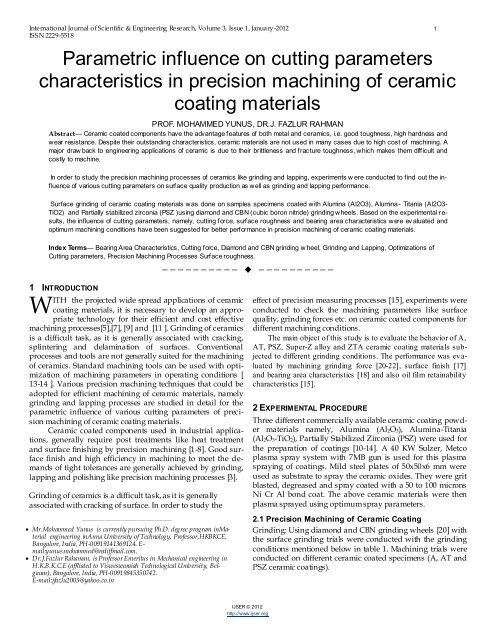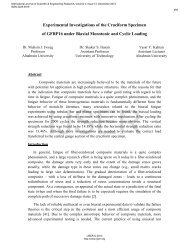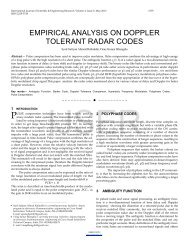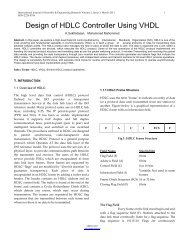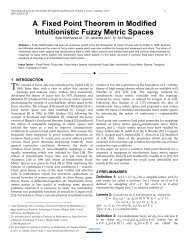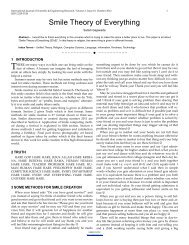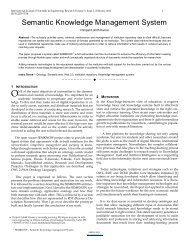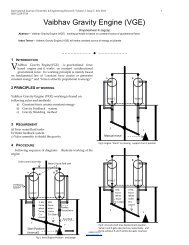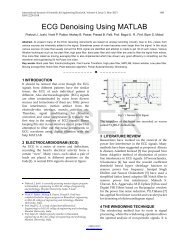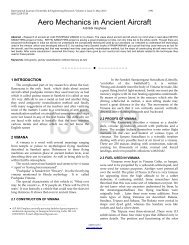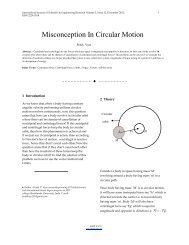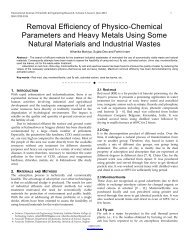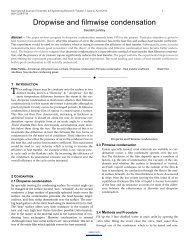Parametric influence on cutting parameters characteristics in ...
Parametric influence on cutting parameters characteristics in ...
Parametric influence on cutting parameters characteristics in ...
You also want an ePaper? Increase the reach of your titles
YUMPU automatically turns print PDFs into web optimized ePapers that Google loves.
Internati<strong>on</strong>al Journal of Scientific & Eng<strong>in</strong>eer<strong>in</strong>g Research, Volume 3, Issue 1, January-2012 1<br />
ISSN 2229-5518<br />
<str<strong>on</strong>g>Parametric</str<strong>on</strong>g> <str<strong>on</strong>g><strong>in</strong>fluence</str<strong>on</strong>g> <strong>on</strong> <strong>cutt<strong>in</strong>g</strong> <strong>parameters</strong><br />
<strong>characteristics</strong> <strong>in</strong> precisi<strong>on</strong> mach<strong>in</strong><strong>in</strong>g of ceramic<br />
coat<strong>in</strong>g materials<br />
PROF. MOHAMMED YUNUS, DR.J. FAZLUR RAHMAN<br />
Abstract— Ceramic coated comp<strong>on</strong>ents have the advantage features of both metal and ceramics, i.e. good toughness, high hardness and<br />
wear resistance. Despite their outstand<strong>in</strong>g <strong>characteristics</strong>, ceramic materials are not used <strong>in</strong> many cases due to high cost of mach<strong>in</strong><strong>in</strong>g. A<br />
major draw back to eng<strong>in</strong>eer<strong>in</strong>g applicati<strong>on</strong>s of ceramic is due to their brittleness and frac ture toughness, which makes them difficult and<br />
costly to mach<strong>in</strong>e.<br />
In order to study the precisi<strong>on</strong> mach<strong>in</strong><strong>in</strong>g processes of ceramics like gr<strong>in</strong>d<strong>in</strong>g and lapp<strong>in</strong>g, experiments w ere c<strong>on</strong>ducted to f<strong>in</strong>d out the <str<strong>on</strong>g><strong>in</strong>fluence</str<strong>on</strong>g><br />
of various <strong>cutt<strong>in</strong>g</strong> <strong>parameters</strong> <strong>on</strong> surface quality producti<strong>on</strong> as well as gr<strong>in</strong>d<strong>in</strong>g and lapp<strong>in</strong>g performance.<br />
Surface gr<strong>in</strong>d<strong>in</strong>g of ceramic coat<strong>in</strong>g materials was d<strong>on</strong>e <strong>on</strong> samples specimens coated with Alum<strong>in</strong>a (Al2O3), Alum<strong>in</strong>a- Titania (Al2O3-<br />
TiO2) and Partially stabilized zirc<strong>on</strong>ia (PSZ )us<strong>in</strong>g diam<strong>on</strong>d and CBN (cubic bor<strong>on</strong> nitride) gr<strong>in</strong>d<strong>in</strong>g wheels. Based <strong>on</strong> the experimental results,<br />
the <str<strong>on</strong>g><strong>in</strong>fluence</str<strong>on</strong>g> of <strong>cutt<strong>in</strong>g</strong> <strong>parameters</strong>, namely, <strong>cutt<strong>in</strong>g</strong> force, surface roughness and bear<strong>in</strong>g area <strong>characteristics</strong> were ev aluated and<br />
optimum mach<strong>in</strong><strong>in</strong>g c<strong>on</strong>diti<strong>on</strong>s have been suggested for better performance <strong>in</strong> precisi<strong>on</strong> mach<strong>in</strong><strong>in</strong>g of ceramic coat<strong>in</strong>g materials.<br />
Index Terms— Bear<strong>in</strong>g Area Characteristics, Cutt<strong>in</strong>g force, Diam<strong>on</strong>d and CBN gr<strong>in</strong>d<strong>in</strong>g w heel, Gr<strong>in</strong>d<strong>in</strong>g and Lapp<strong>in</strong>g, Optimizati<strong>on</strong>s of<br />
Cutt<strong>in</strong>g <strong>parameters</strong>, Precisi<strong>on</strong> Mach<strong>in</strong><strong>in</strong>g Processes Surface roughness.<br />
1 INTRODUCTION<br />
W<br />
ITH the projected wide spread applicati<strong>on</strong>s of ceramic<br />
coat<strong>in</strong>g materials, it is necessary to develop an appropriate<br />
technology for their efficient and cost effective<br />
mach<strong>in</strong><strong>in</strong>g processes[5],[7], [9] and [11 ]. Gr<strong>in</strong>d<strong>in</strong>g of ceramics<br />
is a difficult task, as it is generally associated with crack<strong>in</strong>g,<br />
spl<strong>in</strong>ter<strong>in</strong>g and delam<strong>in</strong>ati<strong>on</strong> of surfaces. C<strong>on</strong>venti<strong>on</strong>al<br />
processes and tools are not generally suited for the mach<strong>in</strong><strong>in</strong>g<br />
of ceramics. Standard mach<strong>in</strong><strong>in</strong>g tools can be used with optimizati<strong>on</strong><br />
of mach<strong>in</strong><strong>in</strong>g <strong>parameters</strong> <strong>in</strong> operat<strong>in</strong>g c<strong>on</strong>diti<strong>on</strong>s [<br />
13-14 ]. Various precisi<strong>on</strong> mach<strong>in</strong><strong>in</strong>g techniques that could be<br />
adopted for efficient mach<strong>in</strong><strong>in</strong>g of ceramic materials, namely<br />
gr<strong>in</strong>d<strong>in</strong>g and lapp<strong>in</strong>g processes are studied <strong>in</strong> detail for the<br />
parametric <str<strong>on</strong>g><strong>in</strong>fluence</str<strong>on</strong>g> of various <strong>cutt<strong>in</strong>g</strong> <strong>parameters</strong> of precisi<strong>on</strong><br />
mach<strong>in</strong><strong>in</strong>g of ceramic coat<strong>in</strong>g materials.<br />
Ceramic coated comp<strong>on</strong>ents used <strong>in</strong> <strong>in</strong>dustrial applicati<strong>on</strong>s,<br />
generally require post treatments like heat treatment<br />
and surface f<strong>in</strong>ish<strong>in</strong>g by precisi<strong>on</strong> mach<strong>in</strong><strong>in</strong>g [1-8]. Good surface<br />
f<strong>in</strong>ish and high efficiency <strong>in</strong> mach<strong>in</strong><strong>in</strong>g to meet the demands<br />
of tight tolerances are generally achieved by gr<strong>in</strong>d<strong>in</strong>g,<br />
lapp<strong>in</strong>g and polish<strong>in</strong>g like precisi<strong>on</strong> mach<strong>in</strong><strong>in</strong>g processes [3].<br />
Gr<strong>in</strong>d<strong>in</strong>g of ceramics is a difficult task, as it is generally<br />
associated with crack<strong>in</strong>g of surface. In order to study the<br />
————————————————<br />
� Mr.Mohammed Yunus is currently pursu<strong>in</strong>g Ph.D. degree program <strong>in</strong>Material<br />
eng<strong>in</strong>eer<strong>in</strong>g <strong>in</strong>Anna University of Technology, Professor,HKBKCE,<br />
Bangalore, India, PH-00919141369124. Email:yunus.mohammed@rediffmail.com.<br />
� Dr.J.Fazlur Rahaman, is Professor Emeritus <strong>in</strong> Mechanical eng<strong>in</strong>eer<strong>in</strong>g <strong>in</strong><br />
H.K.B.K.C.E (affliated to Visweswaraiah Technological University, Belgaum),<br />
Bangalore, India, PH-00919845350742.<br />
E-mail:jfazlu2003@yahoo.co.<strong>in</strong><br />
—————————— � ——————————<br />
IJSER © 2012<br />
http://www.ijser.org<br />
effect of precisi<strong>on</strong> measur<strong>in</strong>g processes [15], experiments were<br />
c<strong>on</strong>ducted to check the mach<strong>in</strong><strong>in</strong>g <strong>parameters</strong> like surface<br />
quality, gr<strong>in</strong>d<strong>in</strong>g forces etc. <strong>on</strong> ceramic coated comp<strong>on</strong>ents for<br />
different mach<strong>in</strong><strong>in</strong>g c<strong>on</strong>diti<strong>on</strong>s.<br />
The ma<strong>in</strong> object of this study is to evaluate the behavior of A,<br />
AT, PSZ, Super-Z alloy and ZTA ceramic coat<strong>in</strong>g materials subjected<br />
to different gr<strong>in</strong>d<strong>in</strong>g c<strong>on</strong>diti<strong>on</strong>s. The performance was evaluated<br />
by mach<strong>in</strong><strong>in</strong>g gr<strong>in</strong>d<strong>in</strong>g force [20-22], surface f<strong>in</strong>ish [17]<br />
and bear<strong>in</strong>g area <strong>characteristics</strong> [18] and also oil film reta<strong>in</strong>ability<br />
<strong>characteristics</strong> [15].<br />
2 EXPERIMENTAL PROCEDURE<br />
Three different commercially available ceramic coat<strong>in</strong>g powder<br />
materials namely, Alum<strong>in</strong>a (Al2O3), Alum<strong>in</strong>a-Titania<br />
(Al2O3-TiO2), Partially Stabilized Zirc<strong>on</strong>ia (PSZ) were used for<br />
the preparati<strong>on</strong> of coat<strong>in</strong>gs [10-14]. A 40 KW Sulzer, Metco<br />
plasma spray system with 7MB gun is used for this plasma<br />
spray<strong>in</strong>g of coat<strong>in</strong>gs. Mild steel plates of 50x50x6 mm were<br />
used as substrate to spray the ceramic oxides. They were grit<br />
blasted, degreased and spray coated with a 50 to 100 micr<strong>on</strong>s<br />
Ni Cr Al b<strong>on</strong>d coat. The above ceramic materials were then<br />
plasma sprayed us<strong>in</strong>g optimum spray <strong>parameters</strong>.<br />
2.1 Precisi<strong>on</strong> Mach<strong>in</strong><strong>in</strong>g of Ceramic Coat<strong>in</strong>g<br />
Gr<strong>in</strong>d<strong>in</strong>g: Us<strong>in</strong>g diam<strong>on</strong>d and CBN gr<strong>in</strong>d<strong>in</strong>g wheels [20] with<br />
the surface gr<strong>in</strong>d<strong>in</strong>g trials were c<strong>on</strong>ducted with the gr<strong>in</strong>d<strong>in</strong>g<br />
c<strong>on</strong>diti<strong>on</strong>s menti<strong>on</strong>ed below <strong>in</strong> table 1. Mach<strong>in</strong><strong>in</strong>g trials were<br />
c<strong>on</strong>ducted <strong>on</strong> different ceramic coated specimens (A, AT and<br />
PSZ ceramic coat<strong>in</strong>gs).
Internati<strong>on</strong>al Journal of Scientific & Eng<strong>in</strong>eer<strong>in</strong>g Research, Volume 3, Issue 1, January-2012 2<br />
ISSN 2229-5518<br />
Table1. Gr<strong>in</strong>d<strong>in</strong>g specificati<strong>on</strong>s<br />
Type of gr<strong>in</strong>d<strong>in</strong>g Surface gr<strong>in</strong>d<strong>in</strong>g<br />
Gr<strong>in</strong>d<strong>in</strong>g wheel used Diam<strong>on</strong>d of 185 grit size<br />
CBN of 120 grit size<br />
Wheel speed used 5 to 30m/sec<br />
Depth of gr<strong>in</strong>d<strong>in</strong>g 10 to 40μm<br />
Work feed 0.5 mm/sec<br />
The ma<strong>in</strong> object of this study is to evaluate the behavior of<br />
A, AT and PSZ ceramic coat<strong>in</strong>gs subjected to different gr<strong>in</strong>d<strong>in</strong>g<br />
c<strong>on</strong>diti<strong>on</strong>s. The performance [18] was evaluated by measur<strong>in</strong>g<br />
1. Gr<strong>in</strong>d<strong>in</strong>g force (Normal and Tangential force)<br />
2. Surface f<strong>in</strong>ish produced which also <strong>in</strong>cludes the bear<strong>in</strong>g<br />
area <strong>characteristics</strong><br />
3. Oil reta<strong>in</strong>ability <strong>characteristics</strong>.<br />
2.2 Force Measurement<br />
The normal gr<strong>in</strong>d<strong>in</strong>g force (Fn) and the tangential force (Ft)<br />
were measured us<strong>in</strong>g gr<strong>in</strong>d<strong>in</strong>g dynamometer [17] and<br />
[21].The ground samples were measured for different surface<br />
f<strong>in</strong>ish <strong>parameters</strong> such as Ra, Rt, and t p us<strong>in</strong>g Taylor Hobs<strong>on</strong>’s<br />
stylus trac<strong>in</strong>g profilometer.<br />
2.3 Lapp<strong>in</strong>g<br />
A circular disc of 200 mm <strong>in</strong> diameter made of bright steel<br />
and a p<strong>in</strong> of 6mm diameter were coated with NiCrAlumel<br />
b<strong>on</strong>d coat of thickness 75μm and subsequently coated with<br />
different coa<strong>in</strong>g materials namely, Alum<strong>in</strong>a (A), Alum<strong>in</strong>a-<br />
Titania (AT), Partial Stabilized Zirc<strong>on</strong>ia (PSZ), Super-Z alloy<br />
and ZTA [19-20].<br />
Table2. Lapp<strong>in</strong>g specificati<strong>on</strong>s<br />
Type of Mach<strong>in</strong>e Flat surface hand lapp<strong>in</strong>g<br />
Lapp<strong>in</strong>g medium Abrasive and diam<strong>on</strong>d compound<br />
paste.<br />
Diam<strong>on</strong>d size 2-10 μ m<br />
Lapp<strong>in</strong>g speed 0.2 m/sec<br />
Lapp<strong>in</strong>g pressure 0.5 MPa<br />
Lapp<strong>in</strong>g time durati<strong>on</strong> 25 m<strong>in</strong>utes<br />
Samples were <strong>in</strong>itially ground to achieve pre lapp<strong>in</strong>g f<strong>in</strong>ish<br />
and then further lapped under the c<strong>on</strong>diti<strong>on</strong>s menti<strong>on</strong>ed<br />
above <strong>in</strong> table 2. The process variables were lapp<strong>in</strong>g time<br />
(rang<strong>in</strong>g 5 to 25 m<strong>in</strong>utes) and size of the diam<strong>on</strong>d abrasives <strong>in</strong><br />
lapp<strong>in</strong>g [18].<br />
The lapped discs were thoroughly cleaned and measurement<br />
<strong>in</strong> respect of surface f<strong>in</strong>ish was made us<strong>in</strong>g Taylor Hobs<strong>on</strong>’s surface<br />
f<strong>in</strong>ish profilometer.<br />
2.4 Oil reta<strong>in</strong>ability test<br />
The oil reta<strong>in</strong>ability of ceramic coated surfaces was estimated<br />
us<strong>in</strong>g SAE 120 lubricat<strong>in</strong>g oil. In order to expla<strong>in</strong> the oil reta<strong>in</strong><br />
ability of ceramic coated surfaces, the coated plates (specimens)<br />
IJSER © 2012<br />
http://www.ijser.org<br />
were ground and lapped to half the area of the plate and the rest<br />
half left as it is. Oil droplets were then put <strong>on</strong> these two parts of<br />
the specimen and left untouched for 3 hours. The specimens with<br />
the oil droplets were then observed further <strong>in</strong>crease <strong>in</strong> diameter<br />
us<strong>in</strong>g a travell<strong>in</strong>g microscope and oil spreadability <strong>on</strong> ground and<br />
lapped surfaces were studied.<br />
3 RESULTS AND DISCUSSION<br />
3.1 Results of Gr<strong>in</strong>d<strong>in</strong>g<br />
It has been noticed that, dur<strong>in</strong>g the gr<strong>in</strong>d<strong>in</strong>g of ceramic coat<strong>in</strong>gs,<br />
gr<strong>in</strong>d<strong>in</strong>g forces were found to be vary<strong>in</strong>g c<strong>on</strong>siderably<br />
with <strong>in</strong>creas<strong>in</strong>g gr<strong>in</strong>d<strong>in</strong>g speed. Also, it is observed that, with<br />
CBN wheels gr<strong>in</strong>d<strong>in</strong>g force comp<strong>on</strong>ents (Ft and Fn) were<br />
found to be higher when compared to diam<strong>on</strong>d gr<strong>in</strong>d<strong>in</strong>g<br />
wheel as shown <strong>in</strong> figures1, 2, 3, 4, 5, 6, 7, 8, 9, 10, 11, 12, 30, 31,<br />
32 and 33. Besides, it is noticed that, the <strong>in</strong>crease <strong>in</strong> the depth<br />
of gr<strong>in</strong>d<strong>in</strong>g, generally improved the surface f<strong>in</strong>ish. Dur<strong>in</strong>g<br />
trials <strong>on</strong> gr<strong>in</strong>d<strong>in</strong>g of ceramic coat<strong>in</strong>gs, gr<strong>in</strong>d<strong>in</strong>g velocity, a<br />
range of 10 – 15 m/sec and depth of gr<strong>in</strong>d<strong>in</strong>g 30µm were assessed<br />
to be more critical. It is also observed gr<strong>in</strong>d<strong>in</strong>g of Alum<strong>in</strong>a-Titania<br />
(AT) and Partially stabilized zirc<strong>on</strong>ia (PSZ) ceramic<br />
coat<strong>in</strong>gs with diam<strong>on</strong>d wheel gave better surface f<strong>in</strong>ish.<br />
3.2 Results of Lapp<strong>in</strong>g<br />
It is c<strong>on</strong>cluded that, surface f<strong>in</strong>ish of lapped ceramic coat<strong>in</strong>gs,<br />
improved with lapp<strong>in</strong>g time and rema<strong>in</strong>s c<strong>on</strong>stant after<br />
15 m<strong>in</strong>utes of lapp<strong>in</strong>g time <strong>in</strong> case of AT and PSZ, whereas <strong>in</strong><br />
case of Alum<strong>in</strong>a (A), it atta<strong>in</strong>s saturati<strong>on</strong> after 20 m<strong>in</strong>utes of<br />
lapp<strong>in</strong>g time. It is also seen am<strong>on</strong>g the coat<strong>in</strong>gs that, AT could<br />
be lapped better than the other two.<br />
Bear<strong>in</strong>g area <strong>characteristics</strong> of sprayed and ceramic coat<strong>in</strong>gs<br />
with diam<strong>on</strong>d wheels are shown <strong>in</strong> figures 36, 37, 38, 39,<br />
40, 41, 42, 43, 44 and 45. It is observed there is no much variati<strong>on</strong><br />
<strong>in</strong> the bear<strong>in</strong>g area <strong>characteristics</strong> of coated ceramic surfaces<br />
subjected to diam<strong>on</strong>d wheel gr<strong>in</strong>d<strong>in</strong>g, but AT exhibits<br />
faster tendency to atta<strong>in</strong> cent percent tp area. With CBN gr<strong>in</strong>d<strong>in</strong>g,<br />
rapid improvement <strong>in</strong> bear<strong>in</strong>g area <strong>characteristics</strong> of<br />
Alum<strong>in</strong>a is observed due to improved gr<strong>in</strong>d<strong>in</strong>g of brittle materials<br />
(like Alum<strong>in</strong>a). This is due to gr<strong>in</strong>d<strong>in</strong>g forces associated<br />
with CBN gr<strong>in</strong>d<strong>in</strong>g wheels, CBN gra<strong>in</strong>s, cuts the ceramics relatively<br />
cooler (CBN is thermally more c<strong>on</strong>ductive) compared<br />
to diam<strong>on</strong>d wheel. It is also seen that, diam<strong>on</strong>d wheel is more<br />
sensitive to gr<strong>in</strong>d<strong>in</strong>g c<strong>on</strong>diti<strong>on</strong> and with CBN wheel it is possible<br />
to go for higher depth of gr<strong>in</strong>d<strong>in</strong>g , because of better<br />
thermal properties of CBN.<br />
3.3 Results of Oil Reta<strong>in</strong>abilty Test<br />
Ceramics f<strong>in</strong>d wider applicati<strong>on</strong>s from bear<strong>in</strong>gs to critical<br />
comp<strong>on</strong>ents of I.C.Eng<strong>in</strong>es. Some of the applicati<strong>on</strong>s require<br />
for porosity c<strong>on</strong>trol to enhance the strength and also to provide<br />
adequate film and damp<strong>in</strong>g qualities. For evaluat<strong>in</strong>g oil<br />
retenti<strong>on</strong> capability and to f<strong>in</strong>d out the surface quality dur<strong>in</strong>g<br />
precisi<strong>on</strong> mach<strong>in</strong><strong>in</strong>g, oil mach<strong>in</strong><strong>in</strong>g test have been carried out.<br />
It is seen that, as sprayed ceramic surface could not reta<strong>in</strong><br />
more oil <strong>on</strong> the surface (because of its layer surface porosity)<br />
and hence the oil film thickness was found to be less, but<br />
thickness of oil film <strong>on</strong> ground and lapped surface was larger
Internati<strong>on</strong>al Journal of Scientific & Eng<strong>in</strong>eer<strong>in</strong>g Research, Volume 3, Issue 1, January-2012 3<br />
ISSN 2229-5518<br />
compared with the as sprayed ceramic surface. This may be<br />
due to the closure of pores <strong>in</strong> surface gr<strong>in</strong>d<strong>in</strong>g. It is seen that,<br />
closure of pores and surface asperities take place <strong>on</strong> the surfaces<br />
of AT and PSZ coat<strong>in</strong>g than with Alum<strong>in</strong>a coat<strong>in</strong>gs.<br />
Lapp<strong>in</strong>g further improved surface f<strong>in</strong>ish of ceramic coat<strong>in</strong>gs<br />
by reduc<strong>in</strong>g porosity and oil film thickness <strong>on</strong> the lapped surface<br />
was corresp<strong>on</strong>d<strong>in</strong>gly higher. The oil reta<strong>in</strong>ability of the<br />
different coated plates after mach<strong>in</strong><strong>in</strong>g to 10μm depth of cut<br />
<strong>on</strong> the basis of three hours observati<strong>on</strong> is shown table 3.<br />
Table 3. Results of oil speadability <strong>in</strong> diameter<br />
C<strong>on</strong>diti<strong>on</strong> Alum<strong>in</strong>a Alum<strong>in</strong>a- Partial stabi-<br />
Titania lized zirc<strong>on</strong>ia<br />
As<br />
sprayed<br />
2 times 2 times 2 times<br />
Gr<strong>in</strong>d<strong>in</strong>g 3 times 1.25times 2.5times<br />
Lapp<strong>in</strong>g 3.5 times 1 time 2.75 times<br />
The occurrence of early bear<strong>in</strong>g area improvement for AT and PSZ coat<strong>in</strong>g<br />
by gr<strong>in</strong>d<strong>in</strong>g and lapp<strong>in</strong>g can be visualized <strong>in</strong> the marg<strong>in</strong>al difference<br />
<strong>in</strong> film thickness.<br />
Fig.1. Normal force v/s gr<strong>in</strong>d<strong>in</strong>g speed us<strong>in</strong>g CBN w heel and<br />
depth of cut 10μm.<br />
Fig. 2. Normal force v/s gr<strong>in</strong>d<strong>in</strong>g speed us<strong>in</strong>g CBN w heel and<br />
depth of cut 20μm.<br />
IJSER © 2012<br />
http://www.ijser.org<br />
Fig. 3. Normal force v/s gr<strong>in</strong>d<strong>in</strong>g speed us<strong>in</strong>g CBN w heel and<br />
depth of cut 30μm.<br />
Fig. 4. Normal force v/s gr<strong>in</strong>d<strong>in</strong>g speed us<strong>in</strong>g CBN w heel and<br />
depth of cut 40μm.<br />
Fig. 5. Normal force v/s gr<strong>in</strong>d<strong>in</strong>g speed us<strong>in</strong>g Diam<strong>on</strong>d w heel<br />
and depth of cut 10μm
Internati<strong>on</strong>al Journal of Scientific & Eng<strong>in</strong>eer<strong>in</strong>g Research, Volume 3, Issue 1, January-2012 4<br />
ISSN 2229-5518<br />
Fig. 6. Normal force v/s gr<strong>in</strong>d<strong>in</strong>g speed us<strong>in</strong>g Diam<strong>on</strong>d w heel<br />
and depth of cut 20μm.<br />
Fig. 7. Normal force v/s gr<strong>in</strong>d<strong>in</strong>g speed us<strong>in</strong>g Diam<strong>on</strong>d w heel<br />
and depth of cut 30μm.<br />
Fig. 8. Normal force v/s gr<strong>in</strong>d<strong>in</strong>g speed us<strong>in</strong>g Diam<strong>on</strong>d w heel<br />
and depth of cut 40μm<br />
IJSER © 2012<br />
http://www.ijser.org<br />
Fig. 9. Tangential force v/s gr<strong>in</strong>d<strong>in</strong>g speed us<strong>in</strong>g CBN w heel and<br />
depth of cut 10μm.<br />
ple, write ―Magnetizatio<br />
Fig. 10. Tangential force v/s gr<strong>in</strong>d<strong>in</strong>g speed us<strong>in</strong>g CBN w heel<br />
and depth of cut 20μm.<br />
m � 1),‖ not just ―A/m.‖ Do not label axes with a ratio of<br />
Fig. 11. Tangential force v/s gr<strong>in</strong>d<strong>in</strong>g speed us<strong>in</strong>g CBN w heel<br />
and depth of cut 30μm.
Internati<strong>on</strong>al Journal of Scientific & Eng<strong>in</strong>eer<strong>in</strong>g Research, Volume 3, Issue 1, January-2012 5<br />
ISSN 2229-5518<br />
.<br />
Fig. 12. Tangential force v/s gr<strong>in</strong>d<strong>in</strong>g speed us<strong>in</strong>g CBN w heel<br />
and depth of cut 40μm.<br />
Fig. 13. Surface roughness (Ra) v/s gr<strong>in</strong>d<strong>in</strong>g speed us<strong>in</strong>g CBN<br />
wheel and depth of cut 10μm.<br />
Fig. 14. Surface roughness (Ra) v/s gr<strong>in</strong>d<strong>in</strong>g speed us<strong>in</strong>g CBN<br />
wheel and depth of cut 10μm.<br />
IJSER © 2012<br />
http://www.ijser.org<br />
Fig. 15. Surface roughness (Ra) v/s gr<strong>in</strong>d<strong>in</strong>g speed us<strong>in</strong>g CBN<br />
wheel and depth of cut 30μm.<br />
Fig. 16. Surface roughness (Ra) v/s gr<strong>in</strong>d<strong>in</strong>g speed us<strong>in</strong>g CBN<br />
wheel and depth of cut 40μm.<br />
Fig. 17. Surface roughness (Ra) v/s gr<strong>in</strong>d<strong>in</strong>g speed us<strong>in</strong>g Diam<strong>on</strong>d<br />
w heel and depth of cut 10μm.
Internati<strong>on</strong>al Journal of Scientific & Eng<strong>in</strong>eer<strong>in</strong>g Research, Volume 3, Issue 1, January-2012 6<br />
ISSN 2229-5518<br />
Fig. 18. Surface roughness (Ra) v/s gr<strong>in</strong>d<strong>in</strong>g speed us<strong>in</strong>g Diam<strong>on</strong>d<br />
w heel and depth of cut 20μm.<br />
Fig. 19. Surface roughness (Ra) v/s gr<strong>in</strong>d<strong>in</strong>g speed us<strong>in</strong>g Diam<strong>on</strong>d<br />
w heel and depth of cut 30μm.<br />
Fig. 20. Surface roughness (Ra) v/s gr<strong>in</strong>d<strong>in</strong>g speed us<strong>in</strong>g Diam<strong>on</strong>d<br />
w heel and depth of cut 40μm.<br />
IJSER © 2012<br />
http://www.ijser.org<br />
Fig. 21. Surface roughness (Ra) v/s lapp<strong>in</strong>g time us<strong>in</strong>g CBN<br />
w heel and depth of cut 0.25μm.<br />
Fig. 22. Surface roughness (Ra) v/s lapp<strong>in</strong>g time us<strong>in</strong>g CBN<br />
w heel and depth of cut 8μm.<br />
Fig. 23. Surface roughness (Ra) v/s lapp<strong>in</strong>g time us<strong>in</strong>g CBN<br />
wheel and depth of cut 14μm.
Internati<strong>on</strong>al Journal of Scientific & Eng<strong>in</strong>eer<strong>in</strong>g Research, Volume 3, Issue 1, January-2012 7<br />
ISSN 2229-5518<br />
Fig. 24. Surface roughness(Ra) v/s lapp<strong>in</strong>g time us<strong>in</strong>g Diam<strong>on</strong>d<br />
wheel and depth of cut 0.25μm.<br />
Fig. 25. Surface roughness(Ra) v/s lapp<strong>in</strong>g time us<strong>in</strong>g Diam<strong>on</strong>d<br />
wheel and depth of cut 8μm.<br />
Fig. 26. Surface roughness(Ra) v/s lapp<strong>in</strong>g time us<strong>in</strong>g Diam<strong>on</strong>d<br />
wheel and depth of cut 14μm.<br />
IJSER © 2012<br />
http://www.ijser.org<br />
Fig. 27. Surface roughness (Rt) v/s lapp<strong>in</strong>g time us<strong>in</strong>g CBN<br />
wheel and depth of cut 0.25μm.<br />
Fig. 28. Surface roughness (Rt) v/s lapp<strong>in</strong>g time us<strong>in</strong>g CBN<br />
wheel and depth of cut 8 μm.<br />
Fig. 29. Surface roughness (Rt) v/s lapp<strong>in</strong>g time us<strong>in</strong>g CBN<br />
wheel and depth of cut 14 μm.
Internati<strong>on</strong>al Journal of Scientific & Eng<strong>in</strong>eer<strong>in</strong>g Research, Volume 3, Issue 1, January-2012 8<br />
ISSN 2229-5518<br />
Fig. 30. Tangential force v/s gr<strong>in</strong>d<strong>in</strong>g speed us<strong>in</strong>g Diam<strong>on</strong>d<br />
wheel and depth of cut 10μm.<br />
Fig. 31. Tangential force v/s gr<strong>in</strong>d<strong>in</strong>g speed us<strong>in</strong>g Diam<strong>on</strong>d<br />
wheel and depth of cut 20μm.<br />
Fig. 32. Tangential force v/s gr<strong>in</strong>d<strong>in</strong>g speed us<strong>in</strong>g Diam<strong>on</strong>d<br />
wheel and depth of cut 30μm.<br />
IJSER © 2012<br />
http://www.ijser.org<br />
Fig. 33. Tangential force v/s gr<strong>in</strong>d<strong>in</strong>g speed us<strong>in</strong>g Diam<strong>on</strong>d<br />
wheel and depth of cut 40μm.<br />
%tр<br />
120<br />
100<br />
80<br />
60<br />
40<br />
20<br />
0<br />
Al₂O₃ Sprayed<br />
0 100<br />
Cut off <strong>in</strong> mm<br />
Al₂O₃<br />
Spray…<br />
Fig. 34. % Bear<strong>in</strong>g area(tp) v/s cutoff for as sprayed Alum<strong>in</strong>a.<br />
%tр<br />
120<br />
100<br />
80<br />
60<br />
40<br />
20<br />
0<br />
0 100<br />
Cut off <strong>in</strong> mm<br />
Al₂O₃-TiO₂<br />
Sprayed<br />
Fig. 35. % Bear<strong>in</strong>g area(tp) v/s cutoff for as sprayed Alum<strong>in</strong>a-<br />
Titania (AT).
Internati<strong>on</strong>al Journal of Scientific & Eng<strong>in</strong>eer<strong>in</strong>g Research, Volume 3, Issue 1, January-2012 9<br />
ISSN 2229-5518<br />
%tр<br />
120<br />
100<br />
80<br />
60<br />
40<br />
20<br />
0<br />
Al₂O₃ -TiO₂ Sprayed<br />
0 5 10<br />
Cut off <strong>in</strong> mm<br />
Al₂O₃-<br />
TiO₂<br />
after<br />
lapp<strong>in</strong>g<br />
Fig. 36. % Bear<strong>in</strong>g area (tp) v/s cutoff after lapp<strong>in</strong>g surface of<br />
Alum<strong>in</strong>a-Titania (AT).<br />
%tр<br />
120<br />
100<br />
80<br />
60<br />
40<br />
20<br />
0<br />
PSZ Sprayed<br />
0 50 100<br />
Cut off <strong>in</strong> mm<br />
PSZ<br />
Sprayed<br />
Fig. 37. % Bear<strong>in</strong>g area (tp) v/s cutoff for as sprayed PSZ.<br />
%tр<br />
120<br />
100<br />
80<br />
60<br />
40<br />
20<br />
0<br />
0<br />
Cut<br />
5<br />
off <strong>in</strong> mm<br />
10 15<br />
Al₂O₃<br />
After<br />
lapp<strong>in</strong>g<br />
Fig. 38. % Bear<strong>in</strong>g area (tp) v/s cutoff after lapp<strong>in</strong>g the surface of<br />
(A).<br />
IJSER © 2012<br />
http://www.ijser.org<br />
%tр<br />
120<br />
100<br />
80<br />
60<br />
40<br />
20<br />
0<br />
0 5<br />
Cut off <strong>in</strong> mm<br />
10<br />
PSZ<br />
after …<br />
Fig. 39. % Bear<strong>in</strong>g area (tp) v/s cutoff after lapp<strong>in</strong>g surface of<br />
PSZ.<br />
Fig. 40. % Bear<strong>in</strong>g area (tp) v/s cutoff, ground w ith diam<strong>on</strong>d<br />
wheel for Alum<strong>in</strong>a-Titania (AT).<br />
tр<br />
120<br />
100<br />
80<br />
60<br />
40<br />
20<br />
0<br />
PSZ After Ground<br />
0 5 10 15 20 25<br />
Cut off <strong>in</strong> mm<br />
PSZ us<strong>in</strong>g CBN Wheel<br />
Fig. 41 % Bear<strong>in</strong>g area (tp) v/s cutoff, ground with CBN w heel<br />
for PSZ.
Internati<strong>on</strong>al Journal of Scientific & Eng<strong>in</strong>eer<strong>in</strong>g Research, Volume 3, Issue 1, January-2012 10<br />
ISSN 2229-5518<br />
tр<br />
120<br />
100<br />
80<br />
60<br />
40<br />
20<br />
0<br />
PSZ After Ground<br />
0 5 10 15 20 25<br />
Cut off <strong>in</strong> mm<br />
PSZ After wear USING<br />
DIAMOND<br />
Fig. 42. % Bear<strong>in</strong>g area (tp) v/s cutoff, ground w ith diam<strong>on</strong>d<br />
wheel for PSZ.<br />
tр<br />
120<br />
100<br />
80<br />
60<br />
40<br />
20<br />
0<br />
Al₂O₃ -TiO₂ After Ground<br />
0 10 20 30 40 50<br />
Cut off <strong>in</strong> mm<br />
Al₂O₃-TiO₂ us<strong>in</strong>g CBN wheel<br />
Fig. 43 % Bear<strong>in</strong>g area (tp) v/s cutoff, ground with CBN w heel<br />
for AT.<br />
tр<br />
120<br />
100<br />
80<br />
60<br />
40<br />
20<br />
0<br />
Al₂O₃ After Ground<br />
Al₂O₃ with diam<strong>on</strong>d wheel<br />
0 2 4 6 8 10 12 14 16<br />
Cut off <strong>in</strong> mm<br />
Fig. 44 % Bear<strong>in</strong>g area (tp) v/s cutoff, ground w ith Diam<strong>on</strong>d<br />
wheel for Alum<strong>in</strong>a (A)<br />
IJSER © 2012<br />
http://www.ijser.org<br />
tр<br />
120<br />
100<br />
80<br />
60<br />
40<br />
20<br />
4 CONCLUSION<br />
0<br />
Al₂O₃ After Ground<br />
0 2 4 6 8 10<br />
Cut off <strong>in</strong> mm<br />
Al₂O₃ us<strong>in</strong>g CBN wheel<br />
Fig. 45 % Bear<strong>in</strong>g area (tp) v/s cutoff, ground with CBN wheel for<br />
Alum<strong>in</strong>a (A)<br />
Oxide ceramics such as Alum<strong>in</strong>a (A), Alum<strong>in</strong>a-Titania (AT)<br />
and Partial stablized zirc<strong>on</strong>ia (PSZ), Zirc<strong>on</strong>ia Toughened<br />
Alum<strong>in</strong>a (ZTA) and Super-Z alloy have been widely used for<br />
many <strong>in</strong>dustrial applicati<strong>on</strong>s by depositi<strong>on</strong> of thick film of<br />
hard materials <strong>on</strong> a relatively softer substrate of the<br />
eng<strong>in</strong>eer<strong>in</strong>g comp<strong>on</strong>ents. Before decid<strong>in</strong>g <strong>on</strong> particular type of<br />
coat<strong>in</strong>gs, it is essential to look <strong>in</strong>to its <strong>characteristics</strong> which<br />
<strong>in</strong>cludes mach<strong>in</strong>ability for c<strong>on</strong>trol of size and shape of end<br />
products. Hence it has become objective of the present work to<br />
characterise and mach<strong>in</strong>e for precisi<strong>on</strong> and to identify the<br />
optimal c<strong>on</strong>diti<strong>on</strong>s for the development of oxide ceramic<br />
coat<strong>in</strong>gs. Based <strong>on</strong> the trials <strong>on</strong> gr<strong>in</strong>d<strong>in</strong>g and lapp<strong>in</strong>g of<br />
ceramic coat<strong>in</strong>gs the follow<strong>in</strong>g c<strong>on</strong>clusi<strong>on</strong>s are made.<br />
1. With CBN gr<strong>in</strong>d<strong>in</strong>g wheels, gr<strong>in</strong>d<strong>in</strong>g force<br />
comp<strong>on</strong>ents (Ft and Fn) were found be higher when<br />
compared to diam<strong>on</strong>d gr<strong>in</strong>d<strong>in</strong>g wheel[20].<br />
2. It is noticed that, <strong>in</strong>crease <strong>in</strong> depth of gr<strong>in</strong>d<strong>in</strong>g,<br />
generally the surface f<strong>in</strong>ish is improved.<br />
3. Dur<strong>in</strong>g gr<strong>in</strong>d<strong>in</strong>g of ceramic coat<strong>in</strong>gs, gr<strong>in</strong>d<strong>in</strong>g<br />
velocity range 10 – 15m/sec and depth of gr<strong>in</strong>d<strong>in</strong>g<br />
30µm were found to be more critical.<br />
4. Gr<strong>in</strong>d<strong>in</strong>g of AT and PSZ ceramic coat<strong>in</strong>gs generally<br />
give better surface f<strong>in</strong>ish with diam<strong>on</strong>d wheel.<br />
5. From the data obta<strong>in</strong>ed by lapp<strong>in</strong>g of ceramic<br />
coat<strong>in</strong>gs, it is observed that, surface f<strong>in</strong>ish <strong>in</strong>creases<br />
with lapp<strong>in</strong>g time and saturati<strong>on</strong> of surface f<strong>in</strong>ish<br />
takes place after 15 m<strong>in</strong>utes of lapp<strong>in</strong>g time <strong>in</strong> the<br />
three ceramic coat<strong>in</strong>g materials menti<strong>on</strong>ed.<br />
6. AT could be lapped better than the other two (<br />
Ra=0.25 µm and Rt= 4.2µm).<br />
7. Surface texture details show that, AT exhibits faster<br />
tendency to atta<strong>in</strong> cent percentage tp area (bear<strong>in</strong>g<br />
area characteristic).
Internati<strong>on</strong>al Journal of Scientific & Eng<strong>in</strong>eer<strong>in</strong>g Research, Volume 3, Issue 1, January-2012 11<br />
ISSN 2229-5518<br />
8. With CBN wheels, it is possible to go for higher depth<br />
of gr<strong>in</strong>d<strong>in</strong>g than us<strong>in</strong>g Diam<strong>on</strong>d gr<strong>in</strong>d<strong>in</strong>g wheel<br />
because of better thermal properties of CBN wheels.<br />
9. The oil reta<strong>in</strong>ability test reveals the thickness of oil<br />
film <strong>on</strong> ground and lapped surfaces were larger<br />
compared with as sprayed ceramic surfaces, which is<br />
due to closure of pores and surface irregularities<br />
tak<strong>in</strong>g place <strong>on</strong> mach<strong>in</strong>ed surfaces. Which ishelpful<br />
from the po<strong>in</strong>t of view of oil film lubricati<strong>on</strong> between<br />
parts hav<strong>in</strong>g relative moti<strong>on</strong>.<br />
The above work has taken as product and development of<br />
ceramic coated surfaces are hav<strong>in</strong>g immense value for <strong>in</strong>dustrial<br />
applicati<strong>on</strong>s.<br />
REFERENCES<br />
[1] ] Erry Yulian T. Adesta, Muhammad Riza, Muataz Hazza,Delvis<br />
Agusman, Rosehan Tool Wear and Surface F<strong>in</strong>ish Investigati<strong>on</strong> <strong>in</strong><br />
High Speed Turn<strong>in</strong>g Us<strong>in</strong>g Cermet Insert by Apply<strong>in</strong>g Negative<br />
Rake Angles European Journal of Scientific Research,Vol.38 (2), 2009,<br />
pp.180-188.<br />
[2] Thamizhmanii S., Kamarud<strong>in</strong> K., Rahim E.A., Saparud<strong>in</strong> A., Hassan<br />
S., 2007. Tool Wear andSurface Roughness <strong>in</strong>n Turn<strong>in</strong>g AISI 8620<br />
us<strong>in</strong>g Coated Ceramic Tool, Proceed<strong>in</strong>gs of The World C<strong>on</strong>gress <strong>on</strong><br />
Eng<strong>in</strong>eer<strong>in</strong>g Vol. II WCE, 2007, L<strong>on</strong>d<strong>on</strong>, UK.<br />
[3] Senthilkumar A., Rajadurai A., and Sornakumar A., 2003.<br />
Mach<strong>in</strong>ability of hardened steel us<strong>in</strong>g alum<strong>in</strong>a based ceramic <strong>cutt<strong>in</strong>g</strong><br />
tools, Internati<strong>on</strong>al Journal o Refractory Metals and HardMaterials,<br />
21 pp. 109-117.<br />
[4] Ms. Shruti Mehta, Mr. Avadhoot Rajurkar, Mr. Jignesh Chauhan, A<br />
Review <strong>on</strong> Current Research Trends <strong>in</strong> Die-S<strong>in</strong>k<strong>in</strong>g Electrical<br />
Discharge Mach<strong>in</strong><strong>in</strong>g of C<strong>on</strong>ductive Ceramics, Internati<strong>on</strong>al Journal<br />
of Recent Trends <strong>in</strong> Eng<strong>in</strong>eer<strong>in</strong>g, Vol. 1(5), 2009, pp.100-104.<br />
[5] Yah<strong>on</strong>g Liang and Sour<strong>in</strong> P Dutta, “Applicati<strong>on</strong> trend <strong>in</strong> advanced<br />
ceramic technology”, Technovati<strong>on</strong> 21(2001), pp. 61-65.<br />
[6] R. A. Mahdav<strong>in</strong>ejad, A. Mahdav<strong>in</strong>ejad, “ED mach<strong>in</strong><strong>in</strong>g of WC-Co”,<br />
Journal of materials process<strong>in</strong>g technology, 162-163, 2005, pp. 637-643.<br />
[7] M. Wakuda, Y. Yamauchi and S. Kanzaki “Effect of work piece<br />
properties <strong>on</strong> mach<strong>in</strong>ability <strong>in</strong> abrasive jet mach<strong>in</strong><strong>in</strong>g of ceramic<br />
materials”, Publicati<strong>on</strong>: Precisi<strong>on</strong> Eng<strong>in</strong>eer<strong>in</strong>g, Volume 26 (2), 2002,<br />
pp. 193-198.<br />
[8] H. Hocheng, K.R. Chang, Material Removal Analysis <strong>in</strong> Abrasive<br />
Water Jet <strong>cutt<strong>in</strong>g</strong> of Ceramic Plates, Journal of Material Process<strong>in</strong>g<br />
Technology, Elsevier, Vol. 40, No. 5, 1994, pp.287-304.<br />
[9] K<strong>on</strong>ig W., Popp M., Precisi<strong>on</strong> Mach<strong>in</strong><strong>in</strong>g of Advanced Ceramics,<br />
Ceramic Bullet<strong>in</strong>, Vol.68 ( 3), 1989, pp.550-553.<br />
[10] Dr.J.Fazlur Rahman and Mohammed Yunus,―Benefits of TBC<br />
Coat<strong>in</strong>gs <strong>on</strong> Eng<strong>in</strong>e applicati<strong>on</strong>s‖, Internati<strong>on</strong>al c<strong>on</strong>ference, INCAM<br />
2009 at Kalsal<strong>in</strong>gam University, Tamil Nadu, India, March 2009.<br />
[11] Dr.J.Fazlur Rahman and Mohammed Yunus, Mechanical and<br />
Tribological <strong>characteristics</strong> of Tungsten Carbide Cobalt HVOF<br />
coat<strong>in</strong>gs, Internati<strong>on</strong>al c<strong>on</strong>ference held at Anjuman college of<br />
Eng<strong>in</strong>eer<strong>in</strong>g, Bhatkal October 2008.<br />
[12] Mohammed yunus, Dr.J. Fazlur rahman, Optimizati<strong>on</strong> of usage<br />
<strong>parameters</strong> of ceramic coat<strong>in</strong>gs <strong>in</strong> high temperature applicati<strong>on</strong>s<br />
IJSER © 2012<br />
http://www.ijser.org<br />
us<strong>in</strong>g Taguchi design, Int. J. of Eng<strong>in</strong>eer<strong>in</strong>g science and Tec<br />
Eng<strong>in</strong>eer<strong>in</strong>g Science and Technology, Vol.3(8), 2011, pp.193- 198.<br />
[13] Mohammed yunus, Dr.J. Fazlur rahman, An <strong>in</strong>vestigati<strong>on</strong> towards<br />
characterizati<strong>on</strong> of thermally sprayed <strong>in</strong>dustrial coat<strong>in</strong>gs, Int. J. of<br />
Advanced Eng<strong>in</strong>eer<strong>in</strong>g Sciences and Technologies Vol.10( 2), 2011,<br />
pp.6364 – 6371.<br />
[14] Mohammed yunus, Dr.J. Fazlur rahman, Optimizati<strong>on</strong> of process<br />
<strong>parameters</strong> of wear and hardness characterizati<strong>on</strong> of <strong>in</strong>dustrial<br />
ceramic coat<strong>in</strong>gs us<strong>in</strong>g Taguchi design approach , Int. J. of Advanced<br />
Eng<strong>in</strong>eer<strong>in</strong>g Sciences and Technologies, Vol.9(2), 2011, pp.193- 198.<br />
[15] S. Gowri, K. Narayana, Precisi<strong>on</strong> Gr<strong>in</strong>d<strong>in</strong>g of Sprayed Ceramic<br />
coat<strong>in</strong>gs, 7 th Annual C<strong>on</strong>ference, ASPE, USA, october 1992.<br />
[16] S. Gowri, K. Narayana, Study <strong>on</strong> Flat Lapp<strong>in</strong>g Characteristics of<br />
Plasma sprayed Ceramic Coat<strong>in</strong>gs, Internati<strong>on</strong>al C<strong>on</strong>ference <strong>on</strong><br />
surface Modificati<strong>on</strong> Technologies, Nagsaka, Japan, october 1993.<br />
[17] Caveney, R.J., Theil N.W., Gr<strong>in</strong>d<strong>in</strong>g Alum<strong>in</strong>a with Dioam<strong>on</strong>d<br />
Abrasive, NBS special publicati<strong>on</strong>b,1972, pp. 99.<br />
[18] Chen. C., Saki.S., InasakiI, Lapp<strong>in</strong>g advanced ceramics, Journal of<br />
Materials and Manufactur<strong>in</strong>g processes, vol 6(2), pp.211-226.<br />
[19] Davis. C.E., A study of the<str<strong>on</strong>g><strong>in</strong>fluence</str<strong>on</strong>g> of flat Lapp<strong>in</strong>g with Diam<strong>on</strong>d<br />
microabrasivray<strong>in</strong>g, Diam<strong>on</strong>d Informati<strong>on</strong> Series 1.32, De<br />
beersIndustrial diam<strong>on</strong>d divii<strong>on</strong>U.K.<br />
[20] H<strong>on</strong>. K.K., Characteristics of force pattern <strong>in</strong> CBN gr<strong>in</strong>d<strong>in</strong>g,1983, 24<br />
th IMTDR c<strong>on</strong>frenve pp.277-283.<br />
[21] Krishnamurhy R, annachalam L.M.,GokulRatnam. C.V., Gr<strong>in</strong>d<strong>in</strong>g<br />
Transformati<strong>on</strong> of toughned Y-ZTP ceramics, Annals of CIRP,<br />
Vol40(1),1991, pp.331-337.<br />
[22] Marshell, Shaw M.C., Forces <strong>in</strong> Dry Surface Gr<strong>in</strong>d<strong>in</strong>g, ASME, pp. 51.<br />
[23] Malkim S., Current Trend <strong>in</strong> CBN Technology, Annals of CIRP vol<br />
34, 1985, Pp. 557-563.


